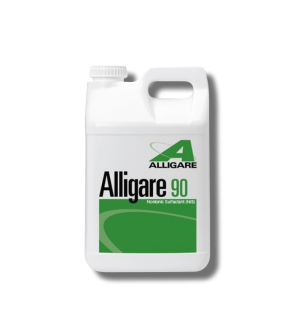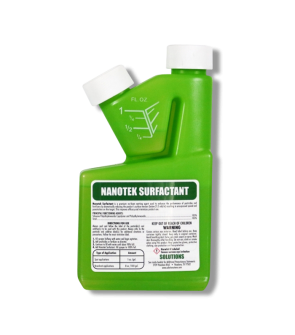Gain access to personalized product screening, the best pricing, rewards, and more!
Most Effective Products
What Is A Surfactant?

Spraying weeds on your lawn with herbicides can be frustrating when the chemical doesn't stick to the plant as you want it to. In this case, it is useful to mix your preferred herbicide with a surfactant for better results.
A surfactant (also known as a wetting agent or spreader/sticker) is a type of chemical additive that acts as a buffer, breaking up the surface tension of a liquid. In weed control products, surfactants are added to the solution to help the product stick to the sprayer surface better and to help break down the plant’s resistance to absorbing the chemical being applied to it.
For maximum effectiveness, a post-emergent herbicide has to contact plant leaves and stay on leaves long enough to seep into the plant and reach the parts of the plant that will damage or disrupt a vital process. The waxy exterior layer of plants and the cuticle of leaves block the way of these chemicals.
The waxy layer and cuticle provide a strong barrier that keeps water and most herbicides from passing through. Water, for instance, when coming into contact with waxy surfaces, tends to transform into beads that bounce or roll off the plant because of water’s high surface tension. This is similar to applying wax on your car, which makes water roll off rather than stick around to dry.
Most surfactants used in pest control are non-ionic, meaning they will not bubble up (like dish soaps do, which are also a type of surfactant). Non-ionic refers to the surfactants' natural ionic charge, which aids in breaking up the surface tension of water or any other liquids that have been added to the solution to help them seep more thoroughly into the plant to which they are applied.
How Surfactant Works

A surfactant is a combination of the phrase “surface active agent,” which is an organic compound that is soluble in chemical solutions or water and allows mixtures to blend, adhere, and work better. Surfactants enhance and help break the barrier of hard-to-penetrate surfaces, like the waxy surface of a leaf.
Adding just a touch of surfactant can increase the effectiveness of all your herbicides by breaking the surface tension of the herbicide and leaf surface. This allows the herbicide of choice to stick around and sit on the leaf surface long enough to be absorbed by the weed, exponentially increasing the herbicide's killing power and reducing the chances of the solution running off and affecting desired plants.
Some herbicides need surfactants, but other products might already have them. This is why it is important to read product labels before adding or mixing anything with your selected herbicide. When choosing a surfactant to mix with your herbicide, we recommend a non-ionic surfactant. Non-ionics are the most universal and work best with herbicides. Our top recommended surfactant is Nanotek Surfactant.
Surfactants are sometimes referred to as “wetting agents” or “wetter spreaders,” which may cause some confusion with adjuvants, which are additives that affect how a herbicide or other chemical functions. Surfactants do qualify as adjuvants, but not all adjuvants are surfactants, so be sure to do your homework before mixing and matching chemicals so you get the desired results.
How To Use Surfactants

Surfactants can be applied in two ways:
- Mix the surfactant with the herbicide in the same container and apply them simultaneously to the plant.
- Or spray the target plant with the wetting agent first, then apply the herbicide.
We recommend the mixing method as it saves time during the application. Some herbicides and pesticides already have surfactants mixed in with the active ingredient.
For example, you may want to mix a surfactant with an herbicide when spraying a broadleaf weed so that the product will better adhere to the leaf surface rather than rolling or dripping off. Another scenario is if you are spraying an insecticide on a plant with a waxy leaf surface. A surfactant will help the product stick and uniformly cover the plant.
Solutions Pest & Lawn carries some of the best surfactants available (such as Nanotek Surfactant), which are guaranteed to drastically improve the effectiveness of your selected herbicide, whether you want to kill weeds, remove fungus, or eliminate lawn pests attacking your yard’s vegetation.
Surfactant Usage Tips

- When using a surfactant with a herbicide, spray directly onto the foliage of individual plants on all sides and contact the growing tips and bud terminals. Make sure leaves are completely covered in your product. Timing is also an important aspect of weed control, so you should apply herbicides when plants are actively growing. Applying in the springtime is ideal since plants are emerging or at the beginning of fall when plants are storing nutrients in preparation for winter.
- Don’t apply herbicides in drought or conditions that might prevent plant growth. Windy days can be dangerous for application, as the chemicals can drift to desirable plants and in living areas where pets and children might be. Keep kids and pets away from treated areas for a few days to ensure safety.
- Always wear proper safety equipment when handling pesticides. This includes eye protection, proper attire to protect skin, and, in some cases, masks for respiratory protection. Now that you know what surfactants are all about, browse our products in the surfactants section and order some in preparation for your next weed-killing spree!
Key Takeaways
What is a Surfactant?
- A surfactant is a combination of the phrase “surface active agent,” which is an organic compound that is soluble in chemical solutions or water and works as an enhancement for herbicide chemicals.
Why are Surfactants Beneficial for Herbicide Applications?
- Surfactants are a helpful supplemental adjuvant that can be added to herbicides by breaking the surface tension of the herbicide and leaf surface. Hence, the herbicide more effectively kills the target plant.
Our Top Surfactant Recommendation
- We highly recommend adding Nanotek Surfactant to herbicides when dealing with hard-to-control weeds to see more effective results.








